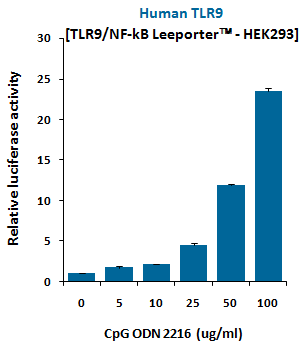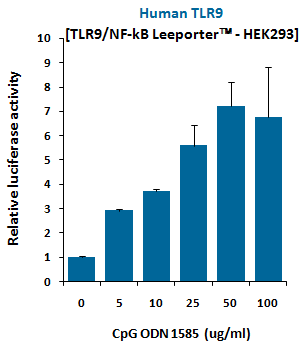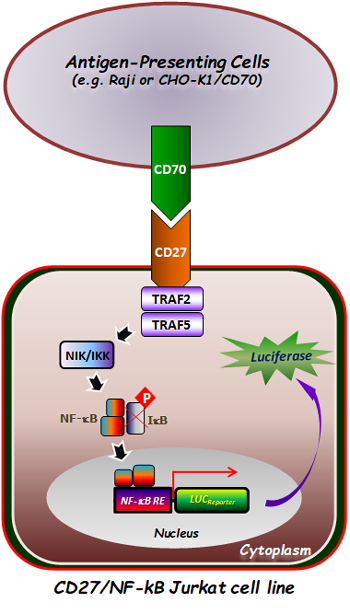Recombinant Human Pro-Neuregulin-1/NRG1- beta 1/HRG1- beta 1 (Ser2-Lys246)
Shipping Info:
For estimated delivery dates, please contact us at [email protected]
| Amount : | 50 µg |
| Content : | Lyophilized from a 0.2 µm filtered solution of 4mM HCl. |
| Storage condition : | Lyophilized protein should be stored at -20°C, though stable at room temperature for 3 weeks. Reconstituted protein solution can be stored at 4-7°C for 2-7 days. Aliquots of reconstituted samples are stable at -20°C for 3 months. |
| AA sequence : | MSERKEGRGKGKGKKKERGSGKKPESAAGSQSPALPPQLKEMKSQESAAGSKLVLRCETSSEYSSLRFKWFKNGNELNRKNKPQNIKIQKKPGKSELRINKASLADSGEYMCKVISKLGNDSASANITIVESNEIITGMPASTEGAYVSSESPIRISVSTEGANTSSSTSTSTTGTSHLVKCAEKEKTFCVNGGECFMVKDLSNPSRYLCKCPNEFTGDRCQNYVMASFYKHLGIEFMEAEELYQK |
Source: E.coli.
MW :26.9kD.
Recombinant Human Neuregulin-1 beta is produced by our E.coli expression system and the target gene encoding Ser2-Lys246 is expressed. Pro-neuregulin-1,Neuregulin-1 beta 1(NRG1) is a single-pass type I membrane protein and belongs to the neuregulin family .It contains 1 EGF-like domain and 1 Ig-like C2-type (immunoglobulin-like) domain. Direct ligand for ERBB3 and ERBB4 tyrosine kinase receptors. The protein concomitantly recruits ERBB1 and ERBB2 coreceptors, resulting in ligand-stimulated tyrosine phosphorylation and activation of the ERBB receptors. The multiple isoforms perform diverse functions such as inducing growth and differentiation of epithelial, glial, neuronal, and skeletal muscle cells; inducing expression of acetylcholine receptor in synaptic vesicles during the formation of the neuromuscular junction; stimulating lobuloalveolar budding and milk production in the mammary gland and inducing differentiation of mammary tumor cells; stimulating Schwann cell proliferation; implication in the development of the myocardium such as trabeculation of the developing heart. Isoform 10 may play a role in motor and sensory neuron development.
MW :26.9kD.
Recombinant Human Neuregulin-1 beta is produced by our E.coli expression system and the target gene encoding Ser2-Lys246 is expressed. Pro-neuregulin-1,Neuregulin-1 beta 1(NRG1) is a single-pass type I membrane protein and belongs to the neuregulin family .It contains 1 EGF-like domain and 1 Ig-like C2-type (immunoglobulin-like) domain. Direct ligand for ERBB3 and ERBB4 tyrosine kinase receptors. The protein concomitantly recruits ERBB1 and ERBB2 coreceptors, resulting in ligand-stimulated tyrosine phosphorylation and activation of the ERBB receptors. The multiple isoforms perform diverse functions such as inducing growth and differentiation of epithelial, glial, neuronal, and skeletal muscle cells; inducing expression of acetylcholine receptor in synaptic vesicles during the formation of the neuromuscular junction; stimulating lobuloalveolar budding and milk production in the mammary gland and inducing differentiation of mammary tumor cells; stimulating Schwann cell proliferation; implication in the development of the myocardium such as trabeculation of the developing heart. Isoform 10 may play a role in motor and sensory neuron development.
Always centrifuge tubes before opening. Do not mix by vortex or pipetting. It is not recommended to reconstitute to a concentration less than 100 µg/ml. Dissolve the lyophilized protein in ddH2O. Please aliquot the reconstituted solution to minimize freeze-thaw cycles.
Endotoxin : Less than 0.1 ng/µg (1 IEU/µg) as determined by LAL test.
For Research Use Only. Not for use in diagnostic/therapeutics procedures.
| Subcellular location: | Membrane |
| Post transnational modification: | N- and O-glycosylated. Extensive glycosylation precedes the proteolytic cleavage (By similarity). |
| Tissue Specificity: | Type I isoforms are the predominant forms expressed in the endocardium. Isoform alpha is expressed in breast, ovary, testis, prostate, heart, skeletal muscle, lung, placenta liver, kidney, salivary gland, small intestine and brain, but not in uterus, stomach, pancreas, and spleen. Isoform 3 is the predominant form in mesenchymal cells and in non-neuronal organs, whereas isoform 6 is the major neuronal form. Isoform 8 is expressed in spinal cord and brain. Isoform 9 is the major form in skeletal muscle cells; in the nervous system it is expressed in spinal cord and brain. Also detected in adult heart, placenta, lung, liver, kidney, and pancreas. Isoform 10 is expressed in nervous system: spinal cord motor neurons, dorsal root ganglion neurons, and brain. Predominant isoform expressed in sensory and motor neurons. Not detected in adult heart, placenta, lung, liver, skeletal muscle, kidney, and pancreas. Not expressed in fetal lung, liver and kidney. Type IV isoforms are brain-specific. |
| BioGrid: | 109332. 71 interactions. |
|
There are currently no product reviews
|






















.png)









